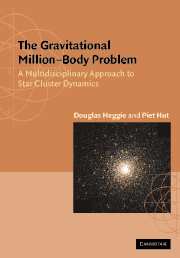Book contents
- Frontmatter
- Contents
- Preface
- PART I INTRODUCTIONS
- PART II THE CONTINUUM LIMIT: N → ∞
- PART III MEAN FIELD DYNAMICS: N = 106
- PART IV MICROPHYSICS: N = 2
- PART V GRAVOTHERMODYNAMICS: N = 106
- PART VI GRAVITATIONAL SCATTERING: N = 3
- PART VII PRIMORDIAL BINARIES: N = 4
- PART VIII POST-COLLAPSE EVOLUTION: N = 106
- PART IX STAR CLUSTER ECOLOGY
- 30 Stellar and Dynamical Evolution
- 31 Collisions and Capture
- 32 Binary Star Evolution and Blue Stragglers
- 33 Star Cluster Evolution
- Appendix A A Simple N-Body Integrator
- Appendix B Hints to Solution of Problems
- References
- Index
33 - Star Cluster Evolution
Published online by Cambridge University Press: 05 June 2012
- Frontmatter
- Contents
- Preface
- PART I INTRODUCTIONS
- PART II THE CONTINUUM LIMIT: N → ∞
- PART III MEAN FIELD DYNAMICS: N = 106
- PART IV MICROPHYSICS: N = 2
- PART V GRAVOTHERMODYNAMICS: N = 106
- PART VI GRAVITATIONAL SCATTERING: N = 3
- PART VII PRIMORDIAL BINARIES: N = 4
- PART VIII POST-COLLAPSE EVOLUTION: N = 106
- PART IX STAR CLUSTER ECOLOGY
- 30 Stellar and Dynamical Evolution
- 31 Collisions and Capture
- 32 Binary Star Evolution and Blue Stragglers
- 33 Star Cluster Evolution
- Appendix A A Simple N-Body Integrator
- Appendix B Hints to Solution of Problems
- References
- Index
Summary
It often happens in science that progress is made, not so much by the discovery of new facts, but by organising knownfacts in a new way. An illustration from chemistry is the periodic table, and in astronomy the HR (Hertzsprung–Russell)diagram is a perfect example. In its modern form this diagram, now called a CM (colour–magnitude) diagram, is a scatter plot of the luminosity or absolute magnitude of a sample of stars plotted against their colour (see Fig. 30.2). It is an immensely powerful tool, so familiar that its power is taken for granted, and it is invaluable for studying the evolution of stars. In this chapter our aim is to provide something comparable for star clusters, though our goal is the much more modest one of helping the reader to grasp in a few pictures the essentials of what has been described in greater detail in earlier chapters of this book.
The links between many of the dynamical processes we have discussed, and one or two others, are summarised in Fig. 33.1. Centre stage is mass loss, which occurs through the agency of several processes. Meanwhile, as the system is losing mass and heading towards oblivion, various processes are also causing its internal structure to evolve. Chief among these is two-body relaxation, which causes more massive stars to segregate inwards, and the core to collapse. Both mechanisms enhance the importance of interactions between primordial binaries, which eventually bring the collapse to a halt.
- Type
- Chapter
- Information
- The Gravitational Million–Body ProblemA Multidisciplinary Approach to Star Cluster Dynamics, pp. 298 - 305Publisher: Cambridge University PressPrint publication year: 2003

